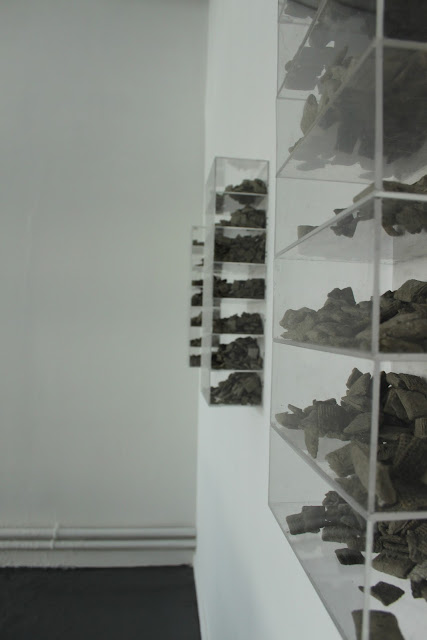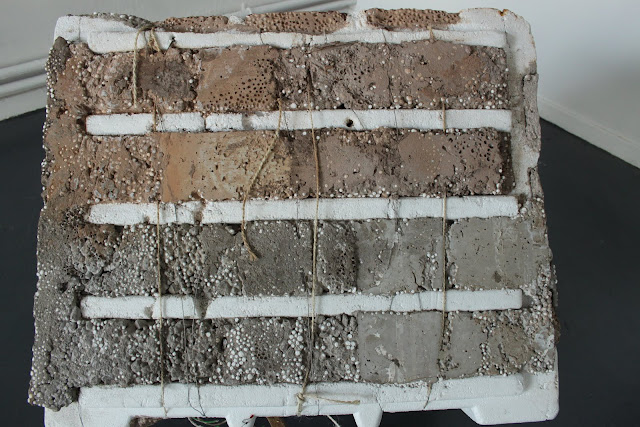____________________________________
Katoikia, (Greek for Habitat) is a three part installation visually narrating the complex poetry of habitats, raising the question of how sentimental habitats are solidified when they cease to exist and are merely a memory. I invite the viewer to dream the space that derives from my effort of keeping alive the memories of my recently demolished family home. The three elements represent three different ways with which the materials work together while telling a story, parallel to different emotional situations I might find myself in whilst changing environments.
The minimal nature of the pieces, act as a bridge of displacement of experiences and memories surrounding a habitat, by commenting on the building’s functional interior and stripping it down to its core, to connect the boundaries of the animate and the inanimate. The choice of materials clearly forces segregation from their primordial utility. Using shredded wheat blocks, concrete, polystyrene and Perspex, I try to comprehensively map the relationship between buildings onto bodies and vice versa. Wheat as a natural fibre builds human bodies the same way as it builds the Plinthari[1]. This cultural reference allows me to explore my heritage in a form of self-expression and confession.
The wall based piece, 21 Perspex bricks are each filled with the exact same weight of shredded wheat blocks reinforced with concrete (. By introducing this laborious process of individually coating them in concrete, sarcastically defeats their mass produced and consumed nature, similarly with Ai Weiwei’s Sunflower Seeds. The same amount of laborious work is put in the transformation of wheat to Plinthari; whereas mine is quite titular, merely to engage with the concept of translating the mundane to art. The repetitive brick like nature of the wheat enhances their potential of being read in a different context. The nature of the bricks as a whole, express a definite dichotomy of nature, but yet not failing to express the balance and the fusion of the traditional and the neoteric. Even though they are confined in the space of the bricks, the way they are arranged can change, they are not bound together. The act of putting the same weight inside the Perspex enhances the unification of the matter; the 312 g. is the exact amount of wheat which would be required to make a plinthari block with the same measurements as the Perspex brick.
The dry stone wall adopts the idea of entropy, in a similar context of Ortega’s practise, by introducing another laborious process from the environment that surrounds me now. The ridges on the concrete casts bond each other to the mass, but if there is one out, they all fall apart. The wall is the median of the works as it is confined in a structure, less constrained than the bricks but much more brittle than the cube.
Exploring the amorphous temperament of the rather dull concrete and mundane polystyrene I metamorphose them from functional objects to a compact, durable block which gives the sense of entrapment. This contrasts the delicacy of the dry stone wall with the whimsicality of the Perspex bricks’ contents.
The process of appropriating memories through the medium of the material liberated them from the continuing compression of not being solid and brings them to life. Determined to achieve catharsis through the work I produce, to give my own interpretation of everyday materials through my own experiences, my work aims to be both an expression of and command over the dialogue between myself, my past, present, the objects’ materiality and the invitation to the viewer to enter my Katoikia.
[1] Plinthari: Cypriot traditional mixture of water, soil and wheat to create a very strong building and eco friendly material.























Simply Wonderful Antonia! xxxxxx
ReplyDelete